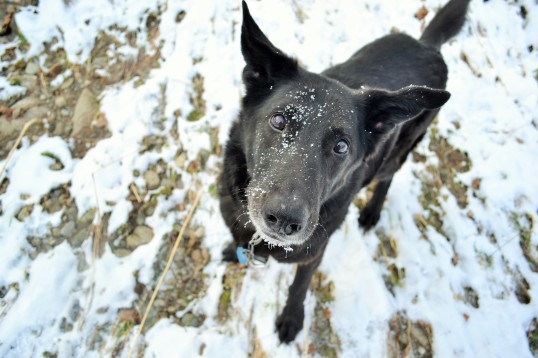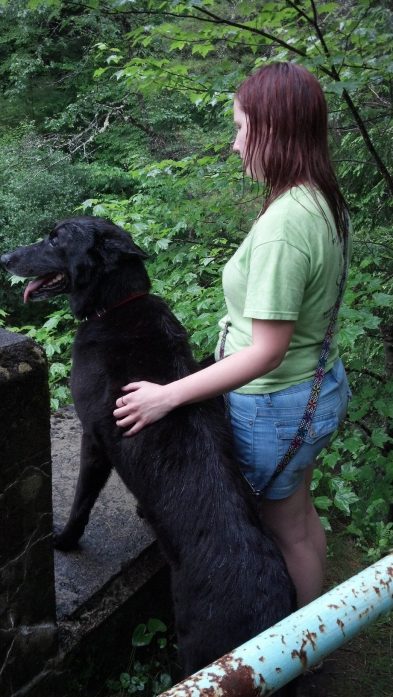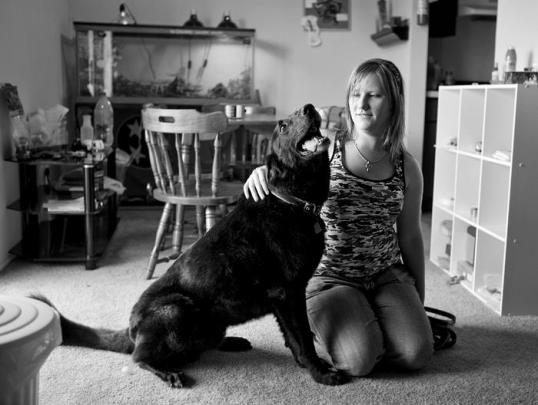I’m writing this in hopes that it will help me grieve and move on. I don’t know that I will ever find peace with what happened, but maybe writing about it will help me accept it. I lost my dog yesterday morning. My awesome, irreplaceable Shadow. Gone.

We adopted him from a shelter in Arkansas in 2002 when I was only 14 years old. I remember that day. Like a typical 14-year-old, I just wanted a cool-looking dog. You know, something badass and wolf-ish. Shadow was the closest thing they had. A big, black dog who looked mostly like a German Shepherd, until you saw his ears – goofy, crooked things that stuck out to the sides like wings on an airplane. They estimated he was about a year old. I picked him out and we were brought outside to the meet-n-greet yard. I crouched down to encourage him to come say hi. He came right toward me and I prepared to be sniffed or licked – until he passed right by me to investigate the smells on the ground. He had zero interest in me. My teenage ego was hurt, but I decided I wanted him anyway. I remember as my mom was signing the paperwork and paying the adoption fee he peed on the front desk. D’oh.
A few hours later, we arrived home. We brought him inside to check the house out, and he promptly peed on my luggage. It was clear we had a marker on our hands. But after that night he never once peed inside a house again. He was mostly an outside dog. Not the most responsible decision, but things were different then. He wasn’t the most clingy or affectionate dog, so he seemed to like it fine. After high school, I moved to Canada for a year and a half and he stayed home with my mom. Then in 2009 I moved to Louisville, KY, where I currently reside.
It was in 2010 that I brought him here to live with me and became totally responsible for him. Back then he had a little trouble adjusting to new places, and of course it changed my life dramatically, so for a while I worried that I had made a mistake and wondered if he’d be happier back with my mom. But I stuck it out and we both adjusted fine. It was nice having something to force me to get out in the fresh air and take relaxing walks every day.

He knew how to sit, but I didn’t start doing any formal training with him until around this time (thus proving old dogs can learn new tricks). I taught him down, shake, stay, touch, jump, spin, play dead, and a damn fine recall if I do say so myself. I could call him back to me in the middle of chasing a squirrel. Considering I was a novice at training, I give him a lot of the credit for simply being a good dog. I’m convinced if he were almost any other dog he would not have learned things half as quickly or performed half as reliably. He was a fantastic dog for a beginner like me. Not just with training, but in general.
Even before training he was so naturally well-behaved. Very mellow, never jumped up on people, rarely begged for food (and was very polite if he did), only barked when someone came to the door. The only accident he ever had indoors was completely my fault for giving him some food that upset his tummy before I left for work. Even near the end of his life when he had awful diarrhea he would ask to go out every time, even if all he had to do was cough up some bile (he hadn’t been eating). The only time he ever got into the trash was when we put a whole turkey carcass in there around Thanksgiving (turkey was one of his favorites). The only time he counter surfed was when I stupidly put that same carcass on the counter after taking it from him the first time. Total human error there.
He was also a somewhat strange dog. Except in the face of thunderstorms and fireworks, he was very calm, confident, independent. But he was very sensitive to people being upset with him. He would slink and offer appeasement gestures left and right to diffuse any anger. If I even used the word “no” during training his morale would take a hit and he would try to disengage. He helped teach me to train with a lot of patience and guidance. When I was being positive and helping him, he loved training with me. It was a great bonding experience for both of us. I admit I was that douchebag owner who walked their dog off leash a lot in the park, but he was not the kind of dog to run up to people or other dogs, and I was not the kind of owner to let him (though I had my dumb moments where I should have been more careful). He stayed close. It was nice that he willingly enjoyed walks with me instead of feeling he was forced to stay with me by a leash.

Walks were his favorite things in the world. If I picked up his collar and leash he got excited and bounced around, grinning from ear to ear. He would even make some gleeful noises akin to Chewbacca if you got him amped up enough. He loved a good squirrel chase or digging after chipmunks. Although when we briefly lived in New Hampshire he messed with the wrong prey animal and got a few porcupine quills to the face, prompting a trip to the emergency vet. He learned not to be so bold with them after that. It wasn’t just small animals he liked to go after, oh no. He certainly enjoyed chasing deer and even tried to go up a tree after a bear once. That was one of the few times I was more grateful than usual for his willingness to listen to and follow me.
He was my buddy on many adventures. We explored many trails, walked in many parades, and he was with me every time I moved to a new place. He was a dignified old man, charming everyone he met. While he’d never turn down the opportunity to go on a walk, he was also content to hang out at home and enjoy a good petting session.

(Photo by Sabarika)
On Saturday December 6th he developed some bad diarrhea and wasn’t eating. He had just been to the vet the prior Thursday to see about pain meds for his achy joints, which I had given to him Friday night. I thought surely these were just side-effects from the meds and if I took him off them he’d be fine, no problem. My vet was convinced something else was going on. Unfortunately, she was right.
Cue another visit to the vet. Blood work looks fine. We go in for an ultrasound and they find a bleeding mass in his spleen. I’m told these are usually caused by an aggressive form of cancer. Either way, the only treatment is surgery. I’m faced with a hard decision. My vet says we could also try an abdominal tap to send some fluids off for analysis and see if there are any cancer cells. I opt to do that, hoping it will give me some insight as to whether or not it’s worth putting him through surgery. On Wednesday the results come back showing no cancer cells (but it’s no guarantee). I decide to take the chance and schedule him for surgery to remove his spleen the next morning. Even though he was at least 13 years old, he was still otherwise very healthy and stable.
Wednesday night was his last good night. The appetite stimulant was working, he was eating some leftover pasta I had heated up for him and loving it. He even had the energy to do a few tricks. It was fantastic to see him almost back to normal and feeling well again. I had my happy buddy back, if only for a few hours.
The next day his surgery goes well, though he does wake up in a bit of pain (and my vet being the awesome person she is goes and buys him some lidocaine patches out of her own pocket to help make him comfortable). His stomach and intestines are also distended from not eating. I bring him home that night. Not surprisingly, he still won’t eat. Even when he was feeling well he was a bit of a picky eater and would refuse to eat if even a little stressed. The next night around 10:00pm I run to the store in my pajama pants and buy a whole chicken to make him some bone broth in the morning (which unfortunately takes around 24 hours).
He has a plethora of pills to take to help with pain, appetite, and his distended innards. Normally it’s very easy to get him to take pills hidden in food. But since he wasn’t eating, that means I had to pill him – which he did not enjoy. Despite all the stress and pain of going to the vet, surgery, and being pilled several times a day, he still trusted me and sought comfort from me. Thursday night he was feeling pretty rough and could only fall asleep if I was softly petting him. It was pretty miserable seeing him in so much discomfort, but I knew he’d get better eventually.

On Friday he still would not eat, so I tried to syringe some Ensure into him with a turkey baster. Poor guy wasn’t a fan of that either. We spent the night at my vet’s house because he just wasn’t feeling well and she was really worried about him not eating. He was restless all night and I was so tired and just wanted to sleep that I got frustrated at him for not settling down and resting. That is something I will regret for a long time. Around 4:30 in the morning I woke up to find his breathing was shallow and he was a bit lethargic. I woke my vet and we took him outside because I knew he needed to pee, but he wouldn’t. She took his temperature to find it was really high. So off to the emergency vet we went.
The doctor came out and talked to me, told me they would likely need to keep him over the weekend. She didn’t hear a heart murmur, his lungs didn’t sound bad, his blood work came back looking okay, blood pressure was fine, the quick flash she did on the ultra sound showed nothing… what could be going on? His heartbeat was unusually fast, though. They said they would call if anything happened, but no news was good news. I went home to try and get some sleep.
Around 8:00am I was out cold and having a dream in which I was wandering around worried about Shadow. The sound of my phone ringing woke me up abruptly. I didn’t recognize the number but deep down I knew who it was. My heart sank as I repeated “no news is good news” in my head. I answered and was told by the vet that Shadow had stopped breathing and his heart had stopped beating right as she was checking it. They were performing CPR but having no luck and asked if I wanted them to continue. I said yes and we ended the call. I began to process what was going on and started to cry. She called back a moment later and said the CPR was still not working. Usually if they don’t get them back by now, they’re not going to. Through tears I choked out, “No… let him go…”
They later found he had aspiration pneumonia. He just didn’t have the strength to fight it. I spent that morning in bed, alternating between crying and being a lifeless zombie. I had always imagined he’d die peacefully in his sleep, or that I would know when it was time and give him the best day of his life before putting him to sleep, feeling content and safe in my arms. Instead he died scared and in pain without me there, and I’d spent some of my last few hours with him frustrated at him. I always knew his death would be hard on me, but that alone made it hit exponentially harder. There was little we could have done, even if we’d known about the pneumonia curveball life threw at us earlier. I will kick myself for not trying harder to get some food in him so he’d have more strength, but I tried.
I arranged to see his body before they cremate him later that day. I don’t want to see him lying there lifeless, but I know I need to say goodbye and pet him one last time for closure. They wheel his body in, covered in blankets. I take his collar off for the last time and start sobbing and petting him softly. He’s stiff. I’m painfully aware he’s no longer in there. All I can do is cry and say I’m sorry. My only solace is that he’s no longer suffering. My vet joins me a few minutes later. She is also a friend and Shadow’s death has hit her pretty hard as well.
I have not felt pain like this since my dad died in early 2002. I know that some day I will be okay, but right now it hurts like I’ve been stabbed in the chest and kicked while I’m down. I could not have asked for a better canine companion. I was lucky to have him. He didn’t deserve the end he got, but sometimes life is just incredibly unfair. I will be okay. Some day. So many friends and family members have been incredibly supportive and comforting, going through this would be much harder without them.
As cliche as it might be, I ask that you never take your dogs for granted and spend more time with them. Be patient and kind. You never know when you’ll be spending your final hours with them.
I’m not a religious person, but I hope like hell there is some sort of afterlife, and that some day Shadow and I will go on adventures again…









